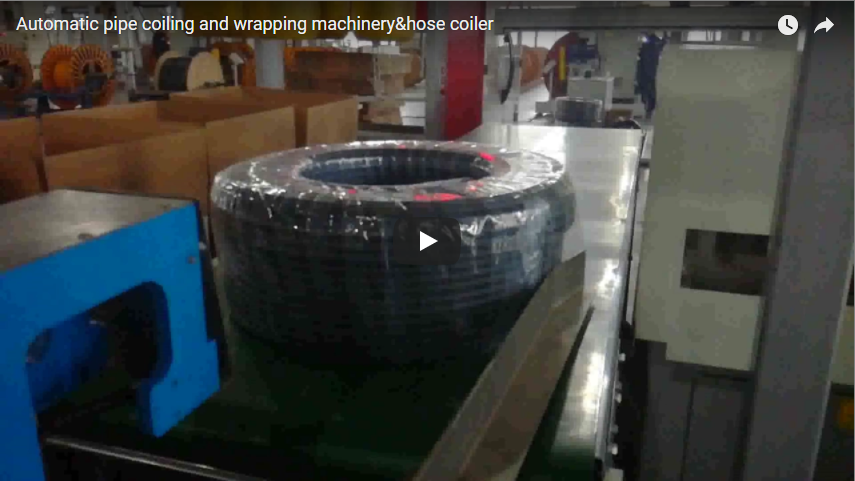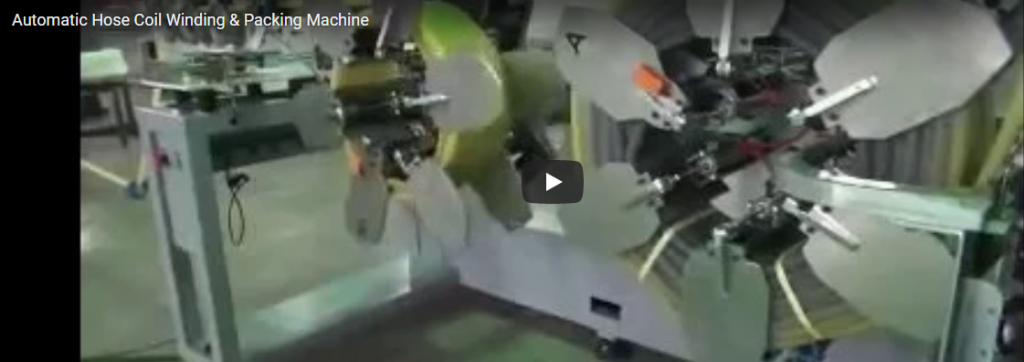Optimizing Hose and Pipe Packaging: A Deep Dive into Automated Coil Wrapping Technology
The efficient and secure packaging of coiled products like industrial hoses and flexible pipes presents unique challenges in manufacturing and distribution environments. Manual or semi-automated processes can be labor-intensive, inconsistent, and may not provide adequate protection, leading to potential product damage and increased operational costs. Automated coil wrapping machinery, particularly vertical ring-style wrappers, offers a robust solution to these challenges, enhancing throughput, ensuring product integrity, and optimizing material usage.
The Mechanics of Vertical Ring Wrapping
Vertical hose coil packing machines, such as those developed by FHOPE, employ orbital wrapping technology. This design features a wrapping ring oriented vertically, through which the hose or pipe coil passes. A film carriage mounted on this ring orbits the coil, dispensing stretch film or other wrapping materials through the coil's eye and around its outer circumference.
Key Operational Principle:
- Orbital Motion: The film carriage travels around the stationary or indexed coil.
- 360-Degree Coverage: This movement allows for complete wrapping coverage around the coil's cross-section, effectively unitizing and protecting the product.
- Vertical Orientation: Often preferred for stability when handling larger or potentially unstable coils, and can integrate seamlessly with certain upstream coiling processes. This approach is reflected in various packaging machinery patents focusing on stable handling of cylindrical or toroidal objects (Ref: Patent classifications like B65B 11/00, B65H 54/00).
Technical Specifications and Performance Metrics
Modern hose coil wrapping systems are engineered for performance and flexibility, catering to diverse industrial needs. Key parameters typically include:
- Coil Size Capacity:
- Outer Diameter (OD): Accommodates a wide range, often from 500mm up to 1500mm or more.
- Inner Diameter (ID): Dependent on coil formation, but machines are designed to allow the wrapping ring passage.
- Coil Width/Height: Handles various widths, often adjustable within the machine's design limits.
- Wrapping Material:
- Primary Material: Linear Low-Density Polyethylene (LLDPE) stretch film is common due to its elasticity, puncture resistance, and cling properties.
- Film Width: Typically ranges from 60mm to 120mm, optimized for coil cross-section coverage.
- Other Options: Potential for using VCI (Vapor Corrosion Inhibitor) film for metal components, woven materials, or paper for specific protection needs.
- Performance:
- Wrapping Speed: Cycle times often range from 20 to 35 seconds per coil, translating to significant throughput potential (e.g., 100+ coils per hour).
- Film Overlap Control: Adjustable via PLC, allowing precise control over wrap density and material consumption (overlap rates typically range from 30% to 70%).
- Pre-Stretch Capabilities: Powered film pre-stretch systems (often achieving 200-300%) significantly reduce film consumption and enhance load stability, a key finding highlighted in packaging efficiency studies (Ref: Industry publications like Packaging Digest and Plastics Technology frequently discuss material reduction through pre-stretch).
Automation and Production Line Integration
A major advantage of modern coil wrapping machines is their potential for full automation and integration into existing production lines.
- Automatic Coiling Integration: FHOPE engineers custom solutions integrating automatic coiling machines that wind pipe or hose directly from an extruder or payoff stand. These systems manage tension control, precise length measurement, cutting, and transferring the finished coil to the wrapping station.
- Extruder Connectivity: Direct connection to an extrusion line enables a continuous, automated process from product formation to final packaging. This eliminates manual handling steps, reduces buffer requirements, and synchronizes packaging speed with production output. Research in manufacturing automation highlights the significant reduction in WIP (Work-In-Progress) and lead times achieved through such integration (Ref: Academic journals on Industrial Engineering and Manufacturing Systems).
- Downstream Integration: Wrapped coils can be automatically transferred to subsequent stations for strapping, labeling, weighing, or robotic palletizing, creating a fully autonomous end-of-line packaging solution.
Operational Efficiency and ROI Considerations
Investing in automated hose coil wrapping technology delivers tangible benefits:
- Reduced Labor Costs: Automating the wrapping process minimizes or eliminates the need for manual labor in this stage, allowing personnel reallocation to higher-value tasks.
- Increased Throughput: Consistent, high-speed wrapping cycles outperform manual methods significantly, keeping pace with demanding production schedules.
- Improved Product Protection: Uniform, tightly applied stretch film protects hoses and pipes from dust, moisture, abrasion, and contamination during storage and transit, reducing costly damage claims.
- Material Savings: Precise overlap control and powered pre-stretch systems optimize film usage, leading to considerable reductions in consumable costs compared to manual or semi-automatic wrapping.
- Enhanced Safety: Automated systems reduce ergonomic risks associated with manually manipulating heavy or awkward coils and handling wrapping materials. Safety features like light curtains, interlocks, and emergency stops are standard.
Ease of Use and Maintenance
Designed for industrial environments, these machines prioritize usability and reliability:
- User Interface: Typically feature intuitive Human-Machine Interfaces (HMIs) with touchscreens for easy setup, parameter adjustment (speed, overlap, tension), and diagnostics.
- Control Systems: Employ robust Programmable Logic Controllers (PLCs) from reputable manufacturers for reliable operation and integration flexibility.
- Durability: Constructed with heavy-duty frames and high-quality components to withstand continuous operation.
- Maintenance Access: Designed for accessibility, simplifying routine maintenance tasks like film roll changes, cleaning, and component servicing to minimize downtime.
Conclusion
Automated hose coil packing machines and pipe wrapping machinery represent a critical technology for manufacturers and distributors dealing with coiled flexible products. By leveraging vertical ring wrapping principles, advanced automation, and integration capabilities, these systems deliver significant improvements in operational efficiency, product protection, cost reduction, and workplace safety. FHOPE's custom-designed solutions, capable of integrating coiling and wrapping functions directly with production lines like extruders, offer a streamlined approach to meet diverse and demanding packaging requirements in the hose and pipe industry.
For more detailed information on specific hose packaging solutions:
https://www.fhopepack.com/Hose-packaging-machine/






